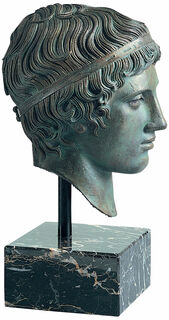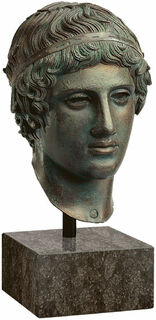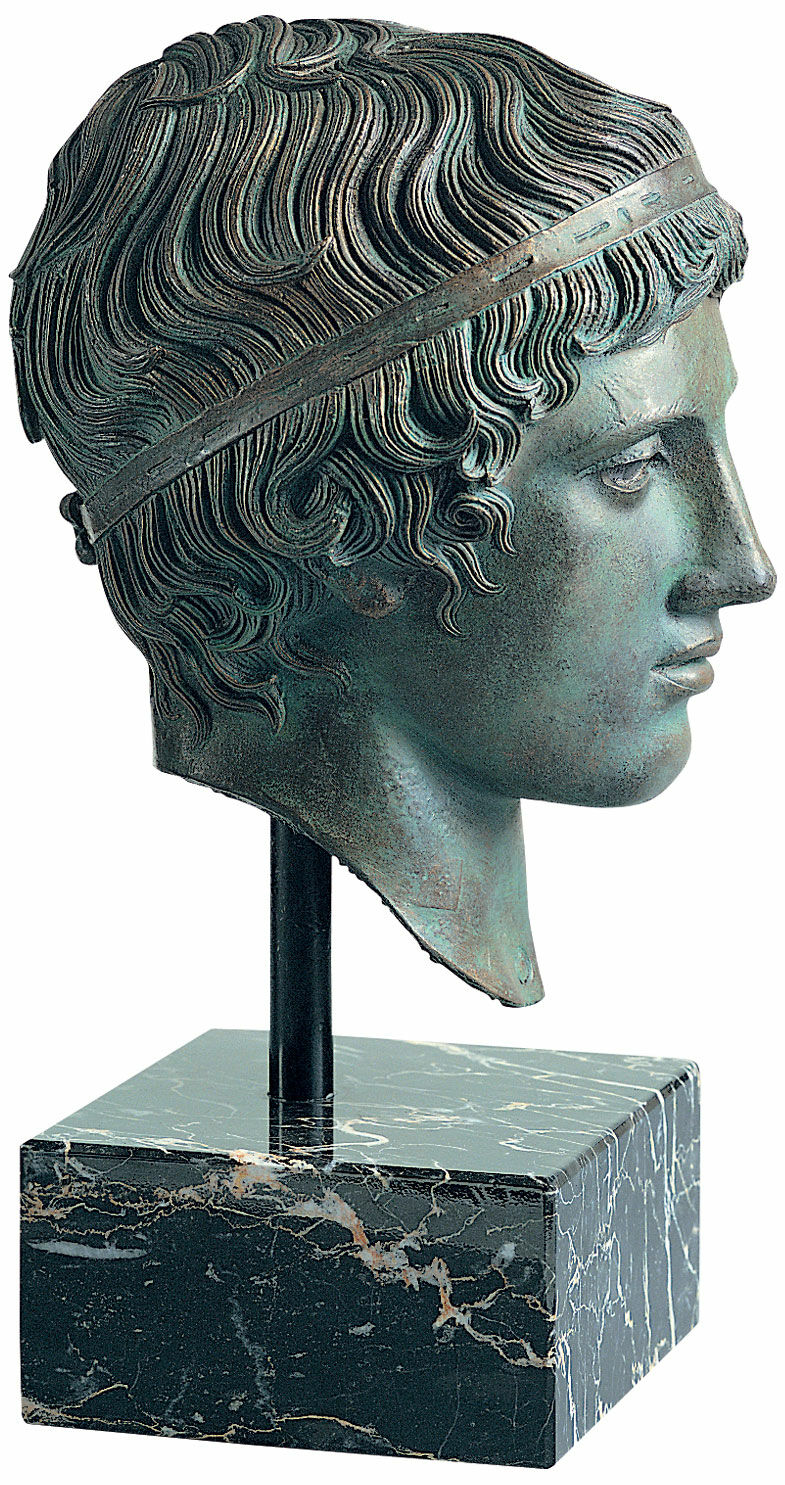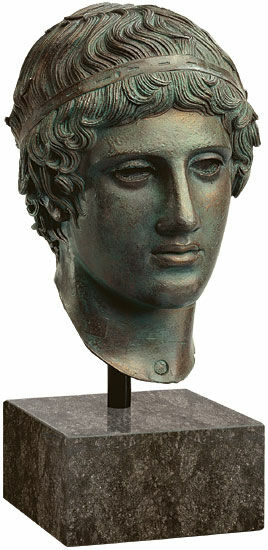Quick info
bronze | patinated | height 33 cm
Detailed description
Ephebe head "Young Man with Fillet of Victory", version in bronze
Rome's vocation was to absorb the legacy of foreign advanced civilisations, and they tried to infuse it with its own essence. This ephebe head with its even features, for example the fillet of victory knotted at the neck, which was perhaps once decorated with silver inlays, or the originally gilded lips, are an almost classical example of this. It is not an epigone copy of a Greek model but rather the artefact of a period that consciously worshipped the strict Attic harmony.
Original: Staatliche Antikensammlungen und Glyptothek, Munich. Roman, around the birth of Christ after a model from the 4th century BC.
Bronze, with fine patina, cast using the Lost-Wax-Process. Height with pedestal 33 cm.
An alloy of copper with other metals (especially with tin) used since ancient times.
When casting bronze, the artist usually applies the lost-wax technique which is dating back more than 5000 years. It's the best, but also the most complex method of producing sculptures.
First, the artist forms a model of his sculpture. It is embedded in a liquid silicone rubber mass. Once the material has solidified, the model is cut out. The liquid wax is poured into the negative mould. After cooling down, the wax cast is removed from the mould, provided with sprues and dipped into ceramic mass. The ceramic mass is hardened in a kiln, whereby the wax flows out (lost mould).
Now we finally have the negative form, into which the 1400° C hot molten bronze is poured. After the bronze had cooled down, the ceramic shell is broken off and the sculpture is revealed.
Now the sprues are removed, the surfaces are polished, patinated and numbered by the artist himself or, to his specifications, by a specialist. Thus, each casting becomes an original work.
For lower-quality bronze castings, the sand casting method is often used which, however, does not achieve the results of a more complex lost-wax technique in terms of surface characteristics and quality.
Sculptural representation of person's head and shoulders.
A true-to-the-original reproduction of an artwork in the same size and with the best possible material and colour uniformity.
The mould is usually taken directly from the original so that the replication reproduces even the finest details. After casting the replication, using the most appropriate method, the surface is polished, patinated, gilded or painted according to the original.
A replication of ars mundi is a recognizable copy of the original.
Roman art is primarily determined by the fusion of native Italic and Greek Hellenistic elements.
The pragmatic and political aspects serving the expansion of the empire played a decisive part in architecture.
In the sacral sphere, the early temples of Rome copied the Etrurian-Italic type. The Roman secular buildings, such as bridges, ports, aqueducts, walls, gates, etc. played a far more important role.
With the remodelling of the Forum Romanum by Augustus and the redesign of the Forum of Augustus, the importance of the old city centres changed. They became large enclosed outdoor space complexes. Axial symmetry aligned with a podium temple is characteristic of the period. The temples and theatres that were built in the "eternal city" under the reign of Emperor Augustus with their round dynamic designs diverged steadily from the straight-lined Greek models.
The round sculptural works of the Roman period were initially dominated by copies and redesigns of Greek models. Independent achievements of Roman sculptors arose in the field of portraits, whereby in Rome, the form of the bust was preferred. A preference for ornamentation without neglecting the substantive content is visual in Roman relief art.
Triumphal paintings that were carried in processions to honour glorious commanders were typical for the painting. The re-excavated Vesuvian cities of Pompeii, Herculaneum, Stabiae and Oplontis provide the richest overview of mural painting.
A similarity to painting is found in mosaic art which was mainly used for the decorative design of floors and walls.
Some areas of minor arts flourished exceedingly in Roman times. Toreutics, the art of working metal, produced precious silver vessels. The art of glassblowing is documented by numerous excellent finds. Glyptic (the art of carving on precious stones) produced magnificent reliefs carved from semi-precious stones, engraved gems and cameos depicting official themes.
The extensive coinage in Roman times contributed to spreading the portraits of the rulers over the entire territory of the Roman Empire.
A plastic work of sculptural art made of wood, stone, ivory, bronze or other metals.
While sculptures from wood, ivory or stone are made directly from the block of material, in bronze casting a working model is prepared at first. Usually, it is made of clay or other easily mouldable materials.
The prime time of sculpture after the Greek and Roman antiquity was the Renaissance. Impressionism gave a new impulse to the sculptural arts. Contemporary artists such as Jorg Immendorf, Andora, and Markus Lupertz also enriched sculptures with outstanding works.






